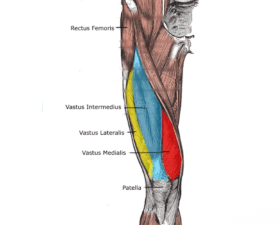When you stand from a sitting position, you use your quads. When you straighten your knee or bend it, you use your quads. When you squat, run or jump? Again, your quads are working hard! It’s easy to see why quad strength keeps you in good shape and is the key to maintaining independence in order to live an active life. Physical therapy is one proven tool to keep quad muscles strong.
Quads can weaken for several reasons, including:
- Injury or overuse. The wrong move during exercise or playing a sport can result in a quadriceps tendon tear, which in turn can cause pain to the knee. Simple overuse in athletics can trigger tendinitis (also spelled “tendonitis”), an inflammation of the tendon.
- Arthritis. Both osteoarthritis and rheumatoid arthritis can inflame the quad tendons.
- Diseases. Conditions like Lyme disease and poliomyelitis can damage muscle tissue.
- Aging. As we grow older, sarcopenia tends to set it, causing skeletal muscles to weaken. Sarcopenia can begin as early as age 40 and accelerates after age 75.
What we call “quads” and are more formally known as the quadriceps femoris muscles is a group of four muscles located in the front and side thigh. They connect to each other just below the kneecap, also known as the patella. They work together to help you move easily, but each of the four has its individual duties as well.
- The rectus femoris starts highest up, at the hip, and serves primarily as the muscle that enables you to extend your knee. When you kick a ball, you’re using the rectus femoris. This muscle also acts as a hip flexor.
- The vastus lateralis, too, helps extend your leg at the knee as well as stabilizing the kneecap. It’s the largest of the four quad muscles and runs along the outside of your thigh.
- The vastus medialis, located along the inner part of your thigh, helps you extend your lower leg and comes into play when you rise from a squatting position.
- The vastus intermedius, located in between the other two vastus muscles in the thigh, is the deepest of the four muscles.
Since each leg’s quads have so much influence over the range of movement of the hip and knee, it’s important to keep quads strong. This may be especially true for women—one study found that, over a period of five years, quadriceps weakness was associated with increased knee pain specifically in women.
Falls are another possible result of weakened quadriceps. It’s not a “chicken or the egg” problem; weak quads come first. “Falls are linked to quad weakness, both of which are common reasons people seek out PT treatment,” states Heather Lane PT’s Dr. Patrick Donovan.
A 2018 study documented that the prevalence of falls among people aged 60 years and older was negatively associated with quad muscle strength (QMS), and this dynamic became even more pronounced after age 70. “This indicates that elderly people with higher QMS are at lower risk of falls, suggesting a beneficial preventive effect of muscle strengthening,” the researchers state.
If you are concerned about weakening quads, Dr. Donovan will design an regimen of exercises customized to address your condition. Your appointment can be in person or through Telehealth.


